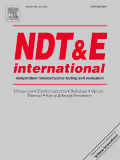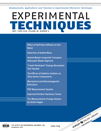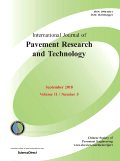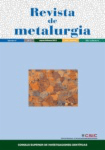
NDT & E INTERNATIONAL
Scope & Guideline
Unveiling Breakthroughs in Mechanical Engineering and Materials Science.
Introduction
Aims and Scopes
- Non-Destructive Testing Techniques:
The journal covers a wide range of NDT techniques, including ultrasonic testing, eddy current testing, thermography, and acoustic emission, among others. It explores advancements in these techniques to improve defect detection, characterization, and evaluation. - Materials Characterization:
Research published in the journal often focuses on the characterization of materials, including composites, metals, and polymers, using NDT methods to assess their integrity, mechanical properties, and structural performance. - Data Analysis and Machine Learning:
There is a strong emphasis on the application of data-driven approaches and machine learning algorithms to enhance the interpretation of NDT data, improve defect detection accuracy, and automate analysis processes. - Integration of Advanced Technologies:
The journal highlights the integration of emerging technologies such as terahertz imaging, laser ultrasonics, and electromagnetic sensors within conventional NDT practices, facilitating new capabilities in defect detection and evaluation. - Structural Health Monitoring:
Research related to the monitoring of structural integrity over time, particularly in critical infrastructure, is a core focus area. This includes the use of NDT methods for ongoing assessment and predictive maintenance. - Innovations in Sensor Development:
The journal features studies on the development and optimization of novel sensors and measurement techniques that enhance the sensitivity and specificity of NDT methods.
Trending and Emerging
- Machine Learning and AI in NDT:
The integration of machine learning and artificial intelligence into NDT practices is rapidly gaining traction. Researchers are exploring how these technologies can improve defect detection, automate analysis, and enhance decision-making processes. - Advanced Imaging Techniques:
There is a growing focus on advanced imaging techniques such as 3D ultrasonic imaging, terahertz imaging, and laser-based methods. These technologies provide higher resolution and more accurate defect characterization, making them increasingly relevant. - Hybrid NDT Approaches:
The trend of combining multiple NDT techniques—such as integrating thermography with ultrasonic testing or electromagnetic methods—is emerging. This hybrid approach enhances the ability to detect and characterize complex defects. - Real-Time Monitoring and Smart NDT:
Research on real-time monitoring systems that utilize IoT and smart technologies is on the rise. These systems enable continuous assessment of structural integrity, facilitating proactive maintenance and management. - Sustainability and Green NDT Practices:
There is an emerging interest in sustainable NDT practices that minimize environmental impact and optimize resource use. Research in this area focuses on developing eco-friendly materials and methods. - Application of NDT in Additive Manufacturing:
As additive manufacturing gains popularity, the application of NDT techniques to assess the integrity of additively manufactured components is trending. This includes research on defect detection and material characterization in 3D-printed parts.
Declining or Waning
- Traditional NDT Methods:
There appears to be a waning interest in traditional NDT methods such as basic visual inspection and older ultrasonic techniques, as researchers increasingly focus on more advanced and automated methods that leverage technology and data analysis. - Non-Quantitative Approaches:
Research that does not incorporate quantitative analysis or data-driven methodologies is becoming less common. The journal's audience is shifting towards studies that provide measurable outcomes and robust statistical validation. - Basic Theoretical Studies:
There is a noticeable decline in purely theoretical studies that do not translate into practical applications or advancements in technology. The emphasis is now on experimental validation and applied research. - Single-Method Studies:
Papers focusing solely on a single NDT method without integration or comparison to other techniques are diminishing. The trend indicates a preference for multi-modal approaches that combine various NDT techniques for enhanced effectiveness.
Similar Journals

EXPERIMENTAL TECHNIQUES
Charting New Paths in Mechanical Engineering ResearchEXPERIMENTAL TECHNIQUES, an esteemed journal published by Springer, serves as a crucial platform for fostering innovation and research in the fields of Mechanical Engineering and Mechanics of Materials. Established in 1975 and continuing its legacy through to 2024, it aggregates a wealth of studies that exemplify rigorous experimental methodologies and emerging technologies. With its remarkable standing as a Q2 journal in Mechanical Engineering and Q3 in Mechanics of Materials, it ranks in the top half of its categories on Scopus, indicating its relevance and impact in the academic community. While the journal is not open access, it ensures accessibility to high-quality research findings essential for advancing knowledge and expertise among researchers, professionals, and students alike. EXPERIMENTAL TECHNIQUES continues to be a vital resource for those involved in the dynamic landscape of experimental mechanics, aiming to push boundaries and explore new frontiers in engineering.

Frattura ed Integrita Strutturale-Fracture and Structural Integrity
Pioneering Research in Fracture MechanicsFrattura ed Integrita Strutturale - Fracture and Structural Integrity is a prominent open-access journal published by GRUPPO ITALIANO FRATTURA since 2007, dedicated to advancing the fields of Civil and Structural Engineering, Mechanical Engineering, and Mechanics of Materials. With an E-ISSN of 1971-8993, this journal has established itself as a significant platform for researchers and practitioners in the engineering community, offering an accessible outlet for high-quality research and innovative methodologies. The journal has achieved impressive standings in the Scopus ranks, notably being positioned in the second quartile (Q2) across its relevant categories in 2023, indicating its growing influence and the quality of the research it disseminates. With a publishing scope extending from 2011 to 2024, Frattura ed Integrita Strutturale continues to be an invaluable resource for addressing the mechanics of material integrity and fracture phenomena, inviting contributions that advance understanding and foster multidisciplinary dialogue. By prioritizing open access, the journal ensures that vital research is readily available to a global audience, enhancing collaboration and knowledge sharing among academia and industry alike.

Structural Monitoring and Maintenance, An International Journal
Pioneering methodologies for sustainable infrastructure.Structural Monitoring and Maintenance, An International Journal is a prestigious publication dedicated to advancing knowledge in the fields of civil and structural engineering, as well as safety, risk, reliability, and quality assessment. Published by TECHNO-PRESS in South Korea, this journal serves as a vital platform for researchers, professionals, and students interested in the latest methodologies, technologies, and case studies pertaining to structural monitoring, assessment, and maintenance practices. With its current Q3 category ranking in both structural engineering and safety metrics, the journal aims to promote high-quality research that addresses real-world challenges in structural integrity and safety. As the journal converges its scope from 2014 to 2024, it continues to welcome innovative studies that contribute to the development of sustainable and resilient infrastructures worldwide. Despite the absence of an open-access option, the substantial readership is ensured through its indexed positions, currently ranked among the top journals in its field according to Scopus metrics. Engage with groundbreaking research that shapes the future of structural engineering and safety practices by delving into the contributions this journal offers.

Bridge Structures
Transforming Engineering Challenges into Bridge SuccessesBridge Structures is an esteemed academic journal dedicated to the field of structural engineering, particularly focusing on the design, analysis, and maintenance of bridge systems. Published by IOS PRESS, a reputable publisher known for its contributions to various scientific fields, the journal serves as an integral platform for disseminating innovative research and advancements within the domain. With an ISSN of 1573-2487 and an E-ISSN of 1744-8999, Bridge Structures has established itself over the years—covering contributions from 2005 to 2024. The journal has attained a commendable ranking within the Q3 category in Building and Construction and holds a position within the 28th percentile among its peers according to the Scopus rankings. Though the journal operates on a subscription basis, its commitment to advancing engineering knowledge is paramount, making it essential reading for researchers, practitioners, and students eager to deepen their understanding of bridge engineering. The journal not only explores theoretical advancements but also emphasizes practical applications, providing a well-rounded perspective on current challenges and solutions in the field of bridge structures.

Quantitative InfraRed Thermography Journal
Illuminating Research Frontiers in Thermal AnalysisWelcome to the Quantitative InfraRed Thermography Journal, an esteemed peer-reviewed journal published by TAYLOR & FRANCIS LTD, dedicated to advancing the field of infrared thermography through rigorous research and innovative methodologies. With its origins dating back to 2004 and an anticipated convergence until 2024, this journal serves as a crucial platform for sharing groundbreaking findings and applications of infrared thermography in Electrical and Electronic Engineering and Instrumentation. Recognized for its quality with a Q1 ranking in both categories and notable positions within the Scopus rankings, the journal attracts high-caliber research and attracts a diverse audience of scholars, practitioners, and students. Although it does not currently offer open access, the journal remains committed to disseminating high-impact research that informs and enriches its readership. Engaging with the Quantitative InfraRed Thermography Journal allows you to stay at the forefront of this dynamic field, fostering collaboration and innovation in thermal imaging and its numerous applications.

Journal of Measurements in Engineering
Exploring the Frontiers of Measurement in EngineeringJournal of Measurements in Engineering is a pioneering open access journal dedicated to the crucial intersection of engineering and measurement technologies, published by JVE INT LTD in Lithuania. Since its transition to open access in 2018, the journal has significantly contributed to the field by providing a platform for disseminating innovative research findings and advances. With a focus on instrumentation, materials science, and mechanical engineering, it has established itself as a valuable resource for researchers, professionals, and students alike, offering insights that bridge theoretical concepts with practical applications. While currently holding a Q4 ranking in Instrumentation and Q3 ranks in both Materials Science (miscellaneous) and Mechanical Engineering, the journal encourages submissions that challenge existing paradigms and extend the boundaries of conventional measurements. As part of its commitment to fostering open scholarly communication, the journal accepts contributions reflecting a wide range of measurement methodologies and engineering applications up to the year 2024. By engaging with a global audience of practitioners and academics, the Journal of Measurements in Engineering underscores the vitality of precise measurement techniques in advancing engineering disciplines.

International Journal of Pavement Research and Technology
Unveiling the science behind resilient pavement solutions.The International Journal of Pavement Research and Technology, published by SpringerNature, stands as a leading platform in the realm of civil and structural engineering, focusing on critical advancements in the field of pavement research. With an ISSN of 1996-6814 and an E-ISSN of 1997-1400, this journal serves an international audience dedicated to enhancing pavement technologies, materials, and practices. Recognized for its rigorous standards, it holds a commendable 2023 Q2 ranking in both Civil and Structural Engineering and Mechanics of Materials, showcasing its influence and relevance in these specialized areas. The journal has been actively publishing since 2009 and continues to explore innovative solutions while addressing pressing challenges in pavement engineering. Although currently not an open-access platform, the findings published within its pages are pivotal for researchers, engineers, and students striving to advance the science and technology of pavement systems. With an emphasis on quality and a commitment to the progress of engineering practices, the journal is an essential resource for those engaged in this dynamic field.

SENSORS AND MATERIALS
Connecting Research and Innovation in Sensors and MaterialsSENSORS AND MATERIALS is a pivotal academic journal dedicated to the dissemination of research in the fields of instrumentation and materials science. Published by MYU, SCIENTIFIC PUBLISHING DIVISION in Japan, this open-access journal has been fostering innovative research since its inception in 1996. With an ISSN of 0914-4935, it serves as a platform for the scholarly communication of studies that intertwine the developments in sensor technology and materials engineering. As of 2023, it occupies a respectable position in the category quartiles, ranking Q3 in both Instrumentation and Materials Science (miscellaneous), reflecting its commitment to quality research. The journal's Scopus rankings further highlight its relevance, being placed at Rank #317 in General Materials Science and Rank #105 in Instrumentation. With its open-access model, SENSORS AND MATERIALS ensures widespread availability of cutting-edge research that is critical for researchers, professionals, and students engaged in advancing the fields of sensor technologies and material innovations.

International Journal of Acoustics and Vibration
Bridging Theory and Application in Acoustics and VibrationInternational Journal of Acoustics and Vibration is a leading peer-reviewed journal published by the International Institute of Acoustics & Vibration, focusing on the diverse fields of acoustics and vibration. With an ISSN of 1027-5851, this journal has been a pivotal resource since its establishment in 2000, examining both fundamental and applied aspects of sound and vibration phenomena that are critical for advancements in engineering and related sciences. Although it does not offer open-access options, it adheres to rigorous standards of academic excellence, as evidenced by its Q3 category rankings in Acoustics and Ultrasonics and Mechanical Engineering, according to the 2023 assessments. The journal's scope encompasses innovative research, theoretical studies, and practical applications, making it essential reading for researchers, professionals, and students aiming to stay updated with the latest developments in these disciplines. With the growing relevance of acoustics and vibration in numerous industries, the International Journal of Acoustics and Vibration serves as a vital platform for disseminating knowledge and fostering collaboration among scholars and practitioners alike.

REVISTA DE METALURGIA
Innovating research in condensed matter and materials chemistry.REVISTA DE METALURGIA, published by the CONSEJO SUPERIOR INVESTIGACIONES CIENTIFICAS-CSIC in Spain, stands as a significant open-access journal since 1995 that focuses on the fields of condensed matter physics, materials chemistry, and the study of metals and alloys. With an ISSN of 0034-8570 and an E-ISSN of 1988-4222, this journal aims to disseminate innovative research findings and reviews that contribute to the understanding and advancement of metallurgical science. Although currently ranked in the fourth quartile across several relevant categories in Scopus, including Materials Science and Physics, its commitment to open access promotes the wider distribution of knowledge in these fields, ensuring that emerging findings are accessible to researchers, industry professionals, and students alike. The journal covers research from its earliest issues in 1968, maintaining a continuous archive that enhances its contributions to the scientific community. For those passionate about the complexities of material properties and behaviors, REVISTA DE METALURGIA serves as a platform for impactful scholarship and collaborative advancement.